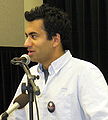It seems that writing about deaccessioning can be as troubling as doing it. This time, it was James Panero’s essay in Wednesday’s Wall Street Journal that
 set tongues wagging and bloggers blogging. Panero, managing editor of The New Criterion, accused the Montclair Art Museum (right) of cleaning house with art sales to shore up its endowment and satisfy the banks. He quotes museum director Lora Urbanelli:
set tongues wagging and bloggers blogging. Panero, managing editor of The New Criterion, accused the Montclair Art Museum (right) of cleaning house with art sales to shore up its endowment and satisfy the banks. He quotes museum director Lora Urbanelli:
“We took out tax exempt bonds at a certain time in our history. And when you do that — we are diligently paying them off — but whenever you do that, as part of the agreement, you agree to have a certain amount on hand in an endowment fund. At times when our endowment is flagging, we go below that line. So this is a creative way to keep the endowment full and to stay above the water line to grow our endowment for acquisitions — just so we are in the good graces with the bond covenants. All the bank wants to know is that the endowment is a healthy one for the size of the institution. There’s nothing untoward.”
But even anti-deaccessioning writers took offense at the essay. And Christopher Knight of the Los Angeles Times, who acknowledges that deaccessioning is sometimes necessary, labeled it a “hit job” — full of innuendo and no proof.
The museum has announced its plans in a press release, but I’m not sure we know all the facts yet.
I am not, as others are, against all deaccessioning, though I deplore many of the recent museum sales. I’m more in tune with the letter that David Ross wrote to the WSJ, published today. The former director of the Whitney and SF MoMA, ever quick with a quote, wrote in his key passage:
The sale of works from a permanent collection should be surgical, not wholesale, and should be done only to enhance the collection — not to satisfy bondholders or bank lenders.
Regardless of how one generation (or administration) feels about the relevance of a particular aspect of the museum’s collection, it should not assume the right to alter the character of the museum, or simply erase the work of previous curators and donors.
Amen.
His whole letter can be read here.
Photo Credit: Montclair Art Museum

 While I was away, the White House did it again — made a stealth arts appointment. Actor Kal Penn (right), who served on candidate Obama’s arts-policy committee, is the new “associate director of public liaison” in the White House, focusing on Asian & Pacific communities and arts communities. The Washington Post had a gossip-column item on this earlier this month, crediting Entertainment Weekly, and yesterday I confirmed it with the White House press office. There’s been no announcement, and spokesman Shin Inouye said he did not know when Penn would start.
While I was away, the White House did it again — made a stealth arts appointment. Actor Kal Penn (right), who served on candidate Obama’s arts-policy committee, is the new “associate director of public liaison” in the White House, focusing on Asian & Pacific communities and arts communities. The Washington Post had a gossip-column item on this earlier this month, crediting Entertainment Weekly, and yesterday I confirmed it with the White House press office. There’s been no announcement, and spokesman Shin Inouye said he did not know when Penn would start. 